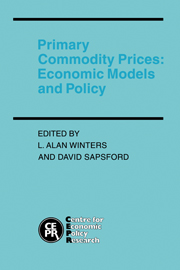Book contents
- Frontmatter
- Contents
- List of figures
- List of tables
- Preface
- List of conference participants
- 1 Primary commodity prices: an introduction to the major policy and modelling challenges
- I ECONOMETRIC ANALYSES
- II SECTORAL STUDIES: FOODS, MATERIALS AND ENERGY
- III STABILIZATION SCHEMES
- 8 The role of futures markets as stabilizers of commodity earnings
- 9 Primary commodity prices and exchange-rate volatility
- 10 Commodity policy: price stabilization versus financing
- Index
8 - The role of futures markets as stabilizers of commodity earnings
from III - STABILIZATION SCHEMES
Published online by Cambridge University Press: 05 March 2012
- Frontmatter
- Contents
- List of figures
- List of tables
- Preface
- List of conference participants
- 1 Primary commodity prices: an introduction to the major policy and modelling challenges
- I ECONOMETRIC ANALYSES
- II SECTORAL STUDIES: FOODS, MATERIALS AND ENERGY
- III STABILIZATION SCHEMES
- 8 The role of futures markets as stabilizers of commodity earnings
- 9 Primary commodity prices and exchange-rate volatility
- 10 Commodity policy: price stabilization versus financing
- Index
Summary
Introduction
Countries which produce primary commodities face rapidly fluctuating prices and revenues from their output and exports. Many of the producing countries, particularly those middle income or poor countries in the third world, depend on commodity exports as their primary source of foreign exchange, employment and development funds. Moreover they are typically dependent on the exports of just one or two commodities, and are therefore unable to diversify away from those price and earnings risks. For example, World Bank figures for 1986 show that out of 42 countries with GNP per head of less than $1,600, 20 were more than 70% dependent on just two commodities for export earnings. Revenue fluctuations can severely restrict growth by interrupting income levels and the flow of development funds in countries which are highly indebted and unable to borrow from the capital markets in order to smooth their revenues. Yet the indebted countries have increasingly relied on commodity exports for servicing their debts.
This paper examines the statistical distribution of earnings from commodity market sales, with arbitrary distributions for market clearing prices and quantities. We are concerned with limiting the impact of demand and supply disturbances by introducing certain rules governing stockholding, or by committing certain quantities to be bought/sold at a known price on the futures market, or by purchasing options to buy/sell at preannounced prices. The producers' decision is then to select an ‘intervention’ rule which improves the earnings distribution, typically either in terms of raising average earnings or of reducing their variance.
- Type
- Chapter
- Information
- Primary Commodity PricesEconomic Models and Policy, pp. 183 - 212Publisher: Cambridge University PressPrint publication year: 1990
- 2
- Cited by

